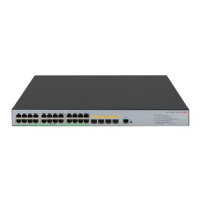95
[SwitchB] display multicast rpf-info 50.1.1.100
[SwitchC] display multicast rpf-info 50.1.1.100
No information is displayed. This means that no RPF route to Source 2 exists on Switch B or Switch
C.
4. Configure a static multicast route:
# Configure a static multicast route on Switch B, specifying Switch A as its RPF neighbor on the
route to Source 2.
[SwitchB] ip rpf-route-static 50.1.1.100 24 30.1.1.2
# Configure a static multicast route on Switch C, specifying Switch B as its RPF neighbor on the
route to Source 2.
[SwitchC] ip rpf-route-static 10.1.1.100 24 20.1.1.2
Verifying the configuration
# Display the RPF routes to Source 2 on Switch B and Switch C.
[SwitchB] display multicast rpf-info 50.1.1.100
RPF information about source 50.1.1.100:
RPF interface: Vlan-interface102, RPF neighbor: 30.1.1.2
Referenced route/mask: 50.1.1.0/24
Referenced route type: static multicast
Route selection rule: preference-preferred
Load splitting rule: disable
[SwitchC] display multicast rpf-info 50.1.1.100
RPF information about source 50.1.1.100:
RPF interface: Vlan-interface101, RPF neighbor: 20.1.1.2
Referenced route/mask: 50.1.1.0/24
Referenced route type: static multicast
Route selection rule: preference-preferred
Load splitting rule: disable
The output shows that the RPF routes to Source 2 exist on Switch B and Switch C. The routes are the
configured static routes.
Multicast forwarding over a tunnel
Network requirements
Multicast routing and PIM-DM are enabled on Switch A and Switch C. Switch B does not support
multicast. OSPF runs on Switch A, Switch B, and Switch C.
Perform the following configurations so that Receiver can receive the multicast data from Source.

